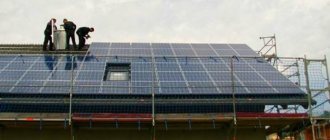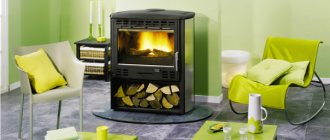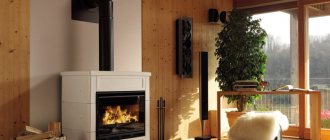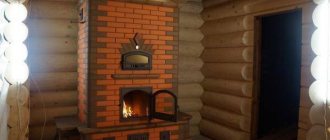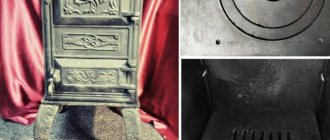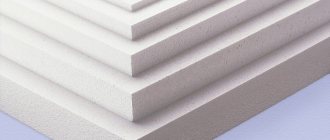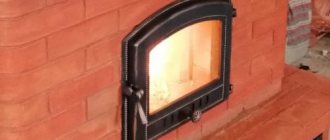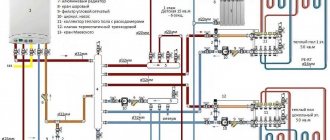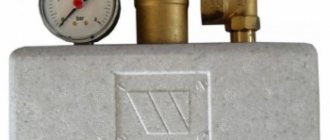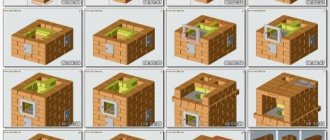Types of cast iron decking
The hob for a cast iron stove can be produced in two types: prefabricated and solid. The differences between these types are insignificant, because both perform their main functions: heating and cooking.
Prefabricated slabs
These structures consist of a sheet of cast iron and several round parts of different types. Cast iron stove rings fit into each other like a puzzle. Due to the fact that the surfaces have gaps, the metal does not deform under the influence of high temperatures.
And the different diameters of the rings allow you to cook food in different dishes as quickly as possible. After all, to heat a large pan of water, you can use a circle with the largest diameter, and it is more convenient to place an iron mug on the smallest part.
Solid slabs
A cast iron sheet for a stove with a solid surface or burners of standard diameter belongs to the category of solid decks. Due to the integrity of the structure, they do not have any gaps for the narrowing and expansion of the metal.
This feature reduces the practicality and durability of such products. But they also have their advantages. Easy installation and relatively low price due to the simplified design are liked by many buyers.
Which is better - steel or cast iron?
The hob for the stove is made of cast iron or metal. Which product has more advantages: cast iron or steel stove plate?
There are a huge number of manufacturers of these products who insist on the advantages of cast iron over steel.
Advantages of cast iron decking:
- strength and durability. A cast iron stove will reliably serve you for decades.
- heat dissipation Due to the presence of certain chemicals in the cast iron used for casting sheets, it has better physical characteristics compared to steel.
- resistance to deformation and corrosion.
- resistance to temperature changes. Due to this, the cast iron hob for the stove retains its original appearance throughout its entire use.
Some manufacturers focus on some other advantages of cast iron compared to steel: cast iron does not dry out the air as much. You don't have to use humidifiers or other devices to maintain indoor humidity.
The main advantages of steel plates are:
- fast heating. In just a couple of minutes the surface heats up to the desired temperature. But such a stove cools down much faster than a cast iron one.
- light weight. Typically, steel plates weigh ten times less than cast iron. This allows for quick installation without much effort. But due to their low weight, such products are able to withstand a small load. If you will be using fairly heavy cookware, it is better to give preference to a cast iron stove.
- low cost. Prices for cast iron stove stoves are higher than for steel stoves. But their service life is much longer.
Conclusion: If your budget allows, use a cast iron surface, it will last longer. If your budget is limited, buy a steel plate.
Oven
The oven, installed in the oven body, is wrapped with asbestos around its entire perimeter. The wall adjacent to the oven is laid out on edge, and the top is covered with a solution two and a half to three centimeters thick. This will prevent the oven walls from burning out quickly.
The oven is usually made of strong steel. Gaps are determined using a level, the frame is wrapped around
sheet asbestos, half a brick wide. The plane of the frame at the top must coincide with the masonry surface of the last row of bricks, therefore, if necessary, the asbestos layer must be increased.
The grate must be installed 25-30 cm below the combustion opening with a slope towards the combustion door. The bottom of the firebox is shaped like a trough, and the slots located between the grates should be along the firebox.
The blower door and, together with it, the cleaning door are installed in the same way as the firebox door. The blower door is practically not exposed to high temperatures, so it must be tightly and firmly walled into the stove masonry, treating the seams with clay mortar. The horizontal of the frame is also determined using a level.
How to choose?
Choosing a cast iron deck for your stove is not difficult. To buy a quality product, the installation of which will not require much effort, it is enough to take into account several nuances.
What are the sizes of cast iron sheets?
Cast iron sheets can be square or rectangular. The most popular are rectangular slabs. The surface dimensions directly depend on the size of the oven.
The standard dimensions of a cast iron stove for a stove are:
- 34 by 41 cm,
- 71 by 41 cm,
- 66 by 41 cm,
- 51 by 34 cm.
For a non-standard stove, you can order the service of manufacturing a cast iron sheet with individual parameters in a specialized store. But it will cost significantly more than standard products.
Number of burners in different models
Typically ovens have two burners. But their number can vary from one to six (it all depends on the surface area). Solid cast iron sheets may have no holes at all. But the cooking time on this type of stove can be long due to the slow heating of the cookware.
Other criteria for choosing a quality product
You should pay attention to the quality and composition of the material from which the stove is made. If you find chips, scratches and other various defects on the surface, then it is better to refuse the purchase. A high-quality product has a smooth surface and its weight is quite large. There are no lightweight cast iron stoves.
It is worth taking the time to study the composition of cast iron. Cast iron, which is used for smelting, is a combination of 2% carbon with iron. But if it contains any components unknown to you, be sure to ask the seller about them. After all, some chemical elements are not environmentally friendly and can harm your health.
Advantages of cast iron
Cast iron provides the product with inertial heat transfer, which means that slow cooling of the surface contributes to uniform heating of the room. Cooking decks are cast from SCh 15-20 cast iron (carbon combined with iron), which is famous for its strength and fire resistance.
Phosphorus, sulfur, silicon and manganese added to the composition enhance the chemical and physical properties. That is why cast iron structures are not subject to temperature changes and remain intact for quite a long time of operation. In addition, any cast iron structures will not be subject to corrosion due to the rusty layer covering them.
Installing a stove on a stove with your own hands
The installation process should begin by studying this issue on specialized sites, and only then start working.
For a brick oven
Installing a cooktop on a brick oven requires some effort. How to properly install a stove on a brick oven?
The following recommendations should be followed:
- There is no need to embed the slab end-to-end. You need to leave a gap of 5 millimeters around the perimeter of the panel. After all, when heated, cast iron tends to expand, and thanks to this installation, the brick oven will not collapse.
1 - During installation, you can use a solution of clay and asbestos.
2
3
4 - A level should be used to lay the slab. This way the cast iron flooring will lie perfectly flat.
- The largest burner in diameter should be installed above the firebox.
- For structural strength, the top row of bricks must be equipped with a piece or angle of steel.
- To increase the strength of cast iron, the first lighting should be done as follows: heat the stove for a long time (7-8 hours). Every hour the temperature should rise by about 70 degrees. Use small logs for the fire, then you can throw in larger ones. After this, the oven should be allowed to cool naturally. This procedure is the key to successful and long-term operation of the entire furnace.
5
Metal
Installing a cast iron surface on a metal stove has the same steps. But it should be taken into account that the cast iron stove has quite a lot of weight.
The steel structure may not withstand it. It is necessary to strengthen the stove additionally: with a corner made of cast iron or other stable metal.
Types of foundations
Among the known types of foundations for arranging furnaces, the following are suitable:
- concrete pillars;
- strip foundation;
- monolithic slab.
Each type has its own characteristics. Concrete pillars are suitable for both a heavy metal stove and a massive brick fireplace. The number of supports is selected based on the total weight of the structure and the condition of the soil at the installation site. To install them, holes of the required size are made in the floor, and after installing the posts, a frame of welded metal channels is laid on them.
Strip foundations are erected according to the classical scheme. According to the method, when constructing them, formwork is first made around the perimeter of the supporting structure, into which liquid concrete is then poured. All other operations are performed in exactly the same way as described in the previous case.
The monolith is mainly used when installing fireplace-type stoves in dachas. Its thickness can reach 15–20 cm, which is quite enough to withstand the design pressure on the foundation.
Any of the types of foundation discussed above must sit for some time after pouring. You can begin installing the stove on it in about 28–30 days.
Overview of cast iron decking
The most popular are Finnish models. But domestic production also produces decent and high-quality goods.
- Pilsa (HTT) Plate 3A. Material: cast iron. Black color. Size: 985 x 650. Diameter of burners: Ø 32, 393 mm. Weight: 51 kg. Price – from 49 thousand rubles.
- 2-burner stove “Russian casting”. Cast iron stove 710x410. Weight: 25.08 kg. Price – from 3000 rub.
- 2-burner stove "R". "Furnace casting Russia". Cast iron stove for oven 700 cm by 400 cm. Weight: 25 kg. Price from 3 thousand rubles.
- Cast iron stove for cauldron H2521 “HALMAT stove casting”. Dimensions: 505×455. Weight: 21 kg. Price from 15,000 rub.
- PLATE 5A SVT 301. Manufacturer: SVT. Dimensions: 460 x 700. Price 0t 17,000 rub.
Work process
Installation of a high-quality combustion door. This process must be approached with full responsibility and
seriousness. It is most exposed to thermal and thermal expansion. Therefore, it should be installed so that the space in the stove is overlapped as tightly as possible and the door is securely fastened to the masonry. This oven door is secured with clamps, which are made of steel.
Clamps are made of steel. All ears should protrude 10-12 cm beyond the door frame, and they are fastened with special rivets. The lower part of the door can be secured with a wire about 60 cm long. Before installing the door, you need to wrap the frame with asbestos. The material can be used in the form of cord, crumbs or sheets, moistening with water before use.
In the exact location of the door installation, it is necessary to apply a layer of clay composition to the masonry. When using wire, the ends are hidden in the seams. Be sure to check the horizontal position of the installation with a level and fix it using a wooden strip. One end of this strip is placed on the door frame, and the other on three bricks of the masonry, a brick is placed on top of it. Next, bricks are laid on the mortar, gradually laying the door in the stove mass. Each row starts from the door.
Instructions for use and care
Careful handling of the product will increase its service life.
- The correct first firebox is the key to the durability of the flooring. It is necessary to gradually light the firebox (shavings and small logs first) and allow it to cool for several hours.
- Mechanical damage should be excluded: chips, scratches.
- Rust may appear during storage of the stove. You should not rip it off or try to remove it in other ways. It will disappear during use.
- Do not overload the device.
- It is necessary to ensure that moisture does not fall on the heated flooring.
With proper use and proper care, your stove will last for many years.
Advantages of an army stove
The POV-57 cast iron stove is very economical in fuel consumption.
One load of the unit can heat it for 6-10 hours. Historically, this type of stove was used about fifty years ago to heat barracks and army tents. This is where the name came from. The ease of operation and maintenance of a cast iron stove, as well as safety and low fuel consumption, have significantly increased its popularity and made it possible to use the stove in our time, in conditions where heating with central heating is impossible.
Today, an almost original version of the potbelly stove design is used, which has not been modernized. The reliability of the unit ensures a long service life. Another advantage of a cast iron stove is that you can use not only firewood as fuel, but also construction and wood waste and even household waste.
Conclusion
A cast iron stove stove is an excellent option for cooking and heating the room. A large selection of these products will satisfy even the most fastidious buyer.
Cast iron material is characterized by heat resistance, durability, and ease of use. A high-quality cast iron stove will serve you reliably for several decades.
But its purchase should be made in a specialized store. Experienced consultants will help you choose between a prefabricated or solid slab, and will also select the right size at an affordable price.
Attention must be paid to the quality, absence of defects and weight of the product. You can even install this flooring yourself. To do this, it is worth considering only a few nuances.
When melted and used, cast iron decking will remain in its original condition throughout its entire use. It will become not only a functional item, but also a decoration for your interior.
Chimney installation
Due to the strong heating of the furnace, the temperature in the chimney area can reach 300 °C. If there is a large accumulation of soot in it and it ignites, this figure rises even higher. When installing steel chimney pipes with your own hands, you need to take into account a number of points regarding the order of their installation.
Firstly, the chimney can be laid not only inside the building, but also along the outer surface of the wall (in the attic). Secondly, in the internal spaces of the house it will be necessary to reliably insulate the pipe in the areas where it passes through the ceiling and roof. Finally, the outside of the chimney should be carefully secured to the wall of the building.
In the process of arranging a diversion channel, it is necessary to be guided by the following requirements of the PPB:
- near the walls, the drain pipe should be laid at a distance of approximately 25 cm;
- the surfaces of the walls are first lined with basalt cardboard, and then sheathed with galvanized or stainless steel sheets;
- the holes in the ceiling must be large enough to maintain 25 cm gaps on the sides (they are subsequently filled with basalt insulation).
To install a chimney, it is preferable to use a sandwich pipe made of ceramic and stainless steel, protected by a layer of thermal insulation. If you have available funds, you can install a branded ceiling trim.
Delivery to Moscow Region outside the Moscow Ring Road
The cost of delivery outside the Moscow Ring Road is 40 rubles/km. + 950 rub. for driving a car through the territory inside the Moscow Ring Road. For example, for Balashikha the cost will be 950+15*40= 1450 rubles. The best prices for delivery of orders in the Moscow region! Delivery time - the next working day after ordering (provided that the product is in stock)
Time from 10 to 21 o'clock. An hour before arrival, the courier must call the recipient of the order. The distance from the Moscow Ring Road to the final address is paid at a rate of 40 rubles/km. Delivery is carried out to the entrance or gate of the house. Attention! Unloading is not included in the shipping cost. We draw your attention to the considerable weight of most of the products we offer and ask you to take care of unloading in a timely manner.
Securing the top of the oven door
It is good to cover the doorway with two whole bricks so that they are connected in the center of the door. Often the mortar falls out above the doors and the vertical seam becomes visible. To eliminate this, it is enough to make notches-pits in both bricks in the places where the mortar is laid with the angle of a hammer. Then, when the mortar is compressed in the seams, these pits will hold the mortar in the seam and it will not fall out. Doors with holes are shown here. You can make them yourself by simply drilling holes in a regular door. Very often the fire doors in stoves fail because they have a bad lock (latch), which sometimes falls off after a few days. Even with proper plumb installation, the door without locking begins to open randomly. This happens because there is a heavy handle on the door, and it, like a counterweight, helps open the door. To prevent the door from opening, all sorts of foreign objects are leaned against it - a poker or a piece of wood, which begins to smoke and often catches fire. The industry, apparently, is not able to invent a reliable lock for the fire door. I propose a simple way to get rid of the random opening of doors, at least in those stoves in which smoke is knocked out of the firebox by the wind. This method will help forgetful owners lock the door. If the pipe is laid incorrectly on top of the roof, the wind gets into the pipe and knocks smoke out of the firebox. When there is a strong wind, the door opens and the fire is knocked out along with the smoke, and sometimes burning coals fly out onto the floor. Therefore, if smoke is coming out of the firebox, you should not leave it unattended. In addition, it is imperative to place a sheet of iron on the floor. To prevent the door from opening, you can do this.
What does simple mean?
It is further understood that a simple oven, which can be quickly made with your own hands, should satisfy the requirement. requirements:
- A person building such a stove does not need to have a deep understanding of the stove business. Ideally, he doesn't need to understand anything about it at all;
- The stove must operate on low-quality waste fuel with a thermal efficiency (this is analogous to the efficiency of heat engines) of at least 35-40%;
- A brick kiln should not require long-term drying after construction and “accelerating” fireboxes to reach the rated thermal power;
- It should consist of no more than 115-120 bricks, so that all the necessary materials can be brought at one time in the trunk of a car or on a trailer to it;
- Stove fittings (doors, hobs, burners) should be the most common (so that you can use used ones) and/or cheap;
- The masonry of a brick kiln should not contain complex joints, sawn (cut with a grinder) bricks, transitions from red brick to fireclay and steel mortgages.
Criteria for choosing a hob
First, evaluate the dimensions of the panel. This is done at the stage of constructing the stove according to the drawings or later, if the tiles are supposed to be built into the finished product. Cast iron surfaces are made in square or rectangular shape. Most often they are produced in the following sizes:
- 340x410 mm;
- 340x510 mm;
- 340x585 mm;
- 410x660 mm;
- 410x710 mm.
Surface thicknesses range from 8 to 17 mm - this criterion is important to consider if the cooking utensils are large and heavy. Panel weight ranges from 10 to 55 kg
The number of cast iron burners for different stoves depends on the dimensions of the sheet and the owner’s wishes: there are single-burner options, and there are products with six heating points. For a non-standard stove, you can place an order in a specialized store to produce a cast-iron surface according to individual dimensions. But its cost is much more than a standard stove.
Domestic and foreign manufacturers produce cooking surfaces. Of the latter, products from the Finnish brand Pisla are in demand. For example, the two-burner cast iron stove stove NTT 3A, black, 985 x 650 mm, has proven itself well. Additionally, the company offers cast iron products for fireplaces. Domestic production does not lag behind its foreign competitors. The most popular Russian manufacturers are NMK, Litkom, Russian Casting, Furnace Casting Russia, SibStalShar.
What should it be
It would seem that there is nothing easier than replacing the suitable surface of a brick oven with a metal insert with your own hands, getting a stove for cooking. In reality, everything is much more complicated. A stove is a complex device, and the thermophysical processes occurring in it depend on the correct arrangement of its elements.
There are special requirements for furnaces of this type. On the one hand, it must effectively accumulate heat in the thickness of the brickwork, on the other hand, it must take a significant part of the heat to heat the hob . In the summer, when heating the house is not required, the hob should warm up quickly with economical fuel consumption.
Requirements
Theoretically, the hob can be made from any material that can heat up to high temperatures when the stove is fired. In practice, they use cast iron plates with holes covered with a removable lid.
This design allows you to create zones with different temperatures on the stove. The thermal conductivity of cast iron, unlike steel, is not very high, so you can heat food on the plane of the stove, as well as cook or stew it over low heat. And by opening the lid, you can achieve direct heating of the cookware with an open flame, which allows you to quickly boil water or fry food in a frying pan.
The most practical are burners . shown in the photo, consisting of concentric rings of different diameters - they can be selected to fit the size of the bottom of the dish. In addition, the gaps between the rings compensate for the thermal expansion of cast iron that occurs when overheated, and the plate can withstand multiple heating and cooling cycles without damage. Solid cast iron stoves are less reliable and require more careful firing.
Attaching the hermetic door
Hermetic doors, fixed into the masonry using riveted plates, are very heavy. It is difficult to fasten such doors with wire, since their weight pulls the wire out of the masonry, but it is possible if the frame with the doors is secured so that it is installed vertically, and the wire is intertwined with the next two rows of masonry. The plates firmly hold the frame with the doors during laying. Such doors with wire fastening last for decades until the furnace is demolished. Sometimes doors, especially old ones, do not line up with the masonry and a gap forms on top of the door. In such cases, it is better to raise the door up flush with the masonry, and under the door to place thin brick quarters on the mortar or to cut off a part of the brick under the door along its entire width, and for the wire to cut out shallow grooves that rise upward obliquely. It’s easier and safer to fold an arch over the door, as they did in the old days.
Material kindly provided by the site: https://remstd.ru/archives/ustanovka-pechnoy-dverki/ We recommend it!
When building a stove independently, each owner is faced with the installation of special stove elements. Installation is a very responsible job. But not everyone knows how to do it correctly. The following article will tell you in detail about installing a good fire door and all other elements.
Specialized furnace devices include: doors of various purposes, grates and various furnace valves. They are necessary to ensure combustion in the stove and convenient use of the stove. Therefore, all stove elements must be installed efficiently and in good working order.
- before installing the door, you need to check the strength of its fit to the frame itself, the absence of various distortions, the possibility of good fixation of the closure, the free rotation of the blade and the presence of appropriate holes for attaching the door in the brickwork of the stove;
- if any defects are found, they need to be removed or the door replaced;
- it is necessary that the valve gate moves freely in the grooves and completely closes the hole; cracks are not allowed in the frame itself;
- if you plan to heat the stove only with coal, you need to drill a hole measuring 13-18 mm in the gate itself.
